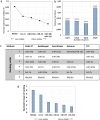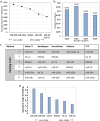The crucial choice of reference genes: identification of miR-191-5p for normalization of miRNAs expression in bone marrow mesenchymal stromal cell and HS27a/HS5 cell lines
- PMID: 33082452
- PMCID: PMC7576785
- DOI: 10.1038/s41598-020-74685-7
The crucial choice of reference genes: identification of miR-191-5p for normalization of miRNAs expression in bone marrow mesenchymal stromal cell and HS27a/HS5 cell lines
Abstract
Bone marrow mesenchymal stromal cells (BM-MSCs) have a critical role in tissue regeneration and in the hematopoietic niche due to their differentiation and self-renewal capacities. These mechanisms are finely tuned partly by small non-coding microRNA implicated in post-transcriptional regulation. The easiest way to quantify them is RT-qPCR followed by normalization on validated reference genes (RGs). This study identified appropriate RG for normalization of miRNA expression in BM-MSCs and HS27a and HS5 cell lines in various conditions including normoxia, hypoxia, co-culture, as model for the hematopoietic niche and after induced differentiation as model for regenerative medicine. Six candidates, namely miR-16-5p, miR-34b-3p, miR-103a-3p, miR-191-5p, let-7a-5p and RNU6A were selected and their expression verified by RT-qPCR. Next, a ranking on stability of the RG candidates were performed with two algorithms geNorm and RefFinder and the optimal number of RGs needed to normalize was determined. Our results indicate miR-191-5p as the most stable miRNA in all conditions but also that RNU6a, usually used as RG is the less stable gene. This study demonstrates the interest of rigorously evaluating candidate miRNAs as reference genes and the importance of the normalization process to study the expression of miRNAs in BM-MSCs or derived cell lines.
Conflict of interest statement
The authors declare no competing interests.
Figures






Similar articles
-
Identification of miRNA Reference Genes in Extracellular Vesicles from Adipose Derived Mesenchymal Stem Cells for Studying Osteoarthritis.Int J Mol Sci. 2019 Mar 5;20(5):1108. doi: 10.3390/ijms20051108. Int J Mol Sci. 2019. PMID: 30841483 Free PMC article.
-
miR-103a-3p and miR-22-5p Are Reliable Reference Genes in Extracellular Vesicles From Cartilage, Adipose Tissue, and Bone Marrow Cells.Front Bioeng Biotechnol. 2021 Feb 15;9:632440. doi: 10.3389/fbioe.2021.632440. eCollection 2021. Front Bioeng Biotechnol. 2021. PMID: 33659243 Free PMC article.
-
Insights into Inflammatory Priming of Adipose-Derived Mesenchymal Stem Cells: Validation of Extracellular Vesicles-Embedded miRNA Reference Genes as A Crucial Step for Donor Selection.Cells. 2019 Apr 23;8(4):369. doi: 10.3390/cells8040369. Cells. 2019. PMID: 31018576 Free PMC article.
-
The role of hypoxia in bone marrow-derived mesenchymal stem cells: considerations for regenerative medicine approaches.Tissue Eng Part B Rev. 2010 Apr;16(2):159-68. doi: 10.1089/ten.TEB.2009.0296. Tissue Eng Part B Rev. 2010. PMID: 19698058 Review.
-
Regulation of the MIR155 host gene in physiological and pathological processes.Gene. 2013 Dec 10;532(1):1-12. doi: 10.1016/j.gene.2012.12.009. Epub 2012 Dec 14. Gene. 2013. PMID: 23246696 Review.
Cited by
-
Optimization of a method for the clinical detection of serum exosomal miR-940 as a potential biomarker of breast cancer.Front Oncol. 2022 Oct 21;12:956167. doi: 10.3389/fonc.2022.956167. eCollection 2022. Front Oncol. 2022. PMID: 36338741 Free PMC article.
-
Reference Genes for qPCR-Based miRNA Expression Profiling in 14 Human Tissues.Med Princ Pract. 2022;31(4):322-332. doi: 10.1159/000524283. Epub 2022 Mar 30. Med Princ Pract. 2022. PMID: 35354155 Free PMC article. Review.
-
MicroRNA-26a-5p is a reliable biomarker in the adjuvant setting for pancreatic ductal adenocarcinoma.PLoS One. 2024 Sep 17;19(9):e0310328. doi: 10.1371/journal.pone.0310328. eCollection 2024. PLoS One. 2024. PMID: 39288140 Free PMC article.
-
Dietary Improvement during Lactation Normalizes miR-26a, miR-222 and miR-484 Levels in the Mammary Gland, but Not in Milk, of Diet-Induced Obese Rats.Biomedicines. 2022 May 31;10(6):1292. doi: 10.3390/biomedicines10061292. Biomedicines. 2022. PMID: 35740314 Free PMC article.
-
Pre-analytical considerations for microRNA quantification in childhood leukemia research.J Biol Methods. 2025 May 27;12(2):e99010062. doi: 10.14440/jbm.2025.0001. eCollection 2025. J Biol Methods. 2025. PMID: 40800069 Free PMC article. Review.
References
Publication types
MeSH terms
Substances
LinkOut - more resources
Full Text Sources
Other Literature Sources

